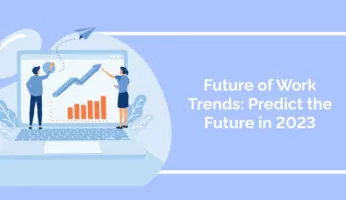
The future workforce will look different in many ways from today’s workforce.
Given the changes sweeping the global business landscape, this shouldn’t be surprising.
After all:
- Digital disruption is driving digital transformation across organizations and industries
- Remote working has become widespread, and many employees want to keep telecommuting
- Organizations are restructuring and changing business models to stay relevant in the modern era
What do these changes hold for the workforce of tomorrow?
Below, we’ll look at some top predictions – and learn how managers and business leaders can prepare.
5 Predictions About the Future Workforce and Workplace
Here are some of the ways the workforce will transform in the coming months and years:
1. The composition of the workforce will change
As younger generations enter the workforce and technology-driven trends alter workflows, we can expect to see workforces themselves change shape.
Many organizations can expect to see:
- A greater diversity in terms of background, age, and skills. Over time, demographic shifts and cultural shifts have increased the diversity of many workplaces, and this is being accentuated by the entry of younger workers into the workforce. One result is that workforces will include a wider variety of perspectives and backgrounds, which can affect the organization’s culture, the workplace climate, team dynamics, and more.
- More contractors and gig workers. The alternative workforce, as Deloitte calls it, will become more common over time. As contract work and gig work becomes increasingly common, workforce dynamics and management styles will need to shift to accommodate these new workers.
- An increased number of telecommuters. Remote work, as we all know, has become normal for many people around the world. It has also given rise to what many call the hybrid office – an office model where some employees work remotely and some work onsite.
- More digitally savvy workers and IT workers. Digital disruptions have shifted the role of IT in the organization. Rather than being a back-office function, IT is now a core driver of business strategy and customer value for many companies. As a consequence, we can expect to see a greater proportion of workforces become digitally skilled and tech-savvy.
These changes to the workforce will go hand-in-hand with other changes, such as those discussed in the next sections.
2. Restructuring will affect jobs and roles
Organizational restructuring has become increasingly common as organizations struggled to adapt to COVID-19, technological change, and other economic shifts.
Restructuring efforts, however, will not only affect the architecture of business structures, but also job roles and responsibilities.
One of the largest drivers of these changes will be digital innovation, particularly automation.
As automation technologies become more advanced, they will gradually absorb more and more complex job tasks. To keep up and stay relevant, employees will need to learn new digital skills, if not change job categories entirely.
The structure of departments may also fundamentally change, and we will likely see the rise of new business functions, such as digital adoption and other IT-driven business units.
3. Management styles will change
All of the factors mentioned earlier will compel managers to change the way they manage employee performance.
For instance:
- Remote working will drive the adoption of management methods that measure employee performance differently
- Managers will need to find ways to manage hybrid teams consistently and effectively, regardless of where team members are located
- New management styles will be needed for the “gig economy” and the increased number of contract workers
Given the impact of management on employee performance and productivity, it will be especially important for managers to rethink their management styles as they adapt to the future of work.
4. Organizational cultures will shift
Many of the factors covered above will also influence organizational cultures in many companies around the world.
Digital transformation, for instance, will drive many companies to adopt a data-driven, digital culture.
Also, to stay adaptable and agile, many businesses will foster cultures of learning and openness to change.
Cultural principles such as these will also affect many other areas of the organization, from talent management to employer branding to the climate of the workplace.
Also, and just as importantly, culture will impact employees’ behavior in key areas – employees who are more open to change and digital technology, for instance, will be less likely to resist digital transformation or adoption strategies.
5. Continuous learning will become embedded in the workplace
Automation, as noted, will impact job roles, job categories, and the skills employees need to succeed.
Digital skills will certainly become essential and more valuable, but so will soft skills, such as empathy, emotional management, and communication skills.
While these latter skills may be more difficult to learn and teach, digital skills training can and will become a central part of many workplaces.
Today, many organizations already recognize the critical importance that employee training plays in keeping a workforce up-to-date and productive.
In 2019, for instance, Amazon invested $700 million to retrain 100,000 employees. And in 2020, they unveiled plans to reskill 29 million people globally for cloud-computing jobs.
While most companies won’t make such extensive investments, Amazon’s example shows how seriously they are taking the issue of upskilling and reskilling – which should indicate the importance of the issue.
WalkMe Team
WalkMe spearheaded the Digital Adoption Platform (DAP) for associations to use the maximum capacity of their advanced resources. Utilizing man-made consciousness, AI, and context-oriented direction, WalkMe adds a powerful UI layer to raise the computerized proficiency, everything being equal.



